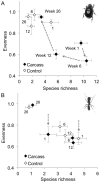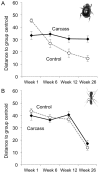Species traits predict assemblage dynamics at ephemeral resource patches created by carrion
- PMID: 23326549
- PMCID: PMC3543354
- DOI: 10.1371/journal.pone.0053961
Species traits predict assemblage dynamics at ephemeral resource patches created by carrion
Abstract
Carrion is an ephemeral and spatially patchy resource that supports a diverse subset of species linked to nutrient cycling and the decomposition process. A number of studies have separately documented changes in the diversity of plants, arthropods and vertebrates at individual carcasses, but there are few studies that have examined how functional traits of different groups of organisms underpin their responses to carrion patches. We used a carrion addition experiment to compare changes in composition and functional traits of insect and plant assemblages at carcasses compared with control sites. We found that significant changes in insect assemblage evenness and heterogeneity was associated with species' dispersal traits, and that plant assemblage responses to subsequent soil nitrogen changes was most apparent among graminoids and exotic species. Beetles at carcasses were twice as large as their counterparts at control sites during the first week of carrion decomposition, and also had higher wing loadings. Plants with high specific leaf area responded faster to the carcass addition, and twice as many species recolonised the centre of carcasses in exotic-dominated grassland compared with carcasses in native-dominated grassland. These results provide an example of how traits of opportunist species enable them to exploit patchy and dynamic resources. This increases our understanding of how carcasses can drive biodiversity dynamics, and has implications for the way carrion might be managed in ecosystems, such as appropriate consideration of spatial and temporal continuity in carrion resources to promote heterogeneity in nutrient cycling and species diversity within landscapes.
Conflict of interest statement
Figures






Similar articles
-
Rewilding with large herbivores: Positive direct and delayed effects of carrion on plant and arthropod communities.PLoS One. 2020 Jan 22;15(1):e0226946. doi: 10.1371/journal.pone.0226946. eCollection 2020. PLoS One. 2020. PMID: 31967995 Free PMC article.
-
Contrasting diversity dynamics of phoretic mites and beetles associated with vertebrate carrion.Exp Appl Acarol. 2014 May;63(1):1-13. doi: 10.1007/s10493-013-9758-7. Epub 2013 Nov 30. Exp Appl Acarol. 2014. PMID: 24292438
-
Decomposition rate of carrion is dependent on composition not abundance of the assemblages of insect scavengers.Oecologia. 2014 Aug;175(4):1291-300. doi: 10.1007/s00442-014-2974-y. Epub 2014 May 26. Oecologia. 2014. PMID: 24859425
-
Carrion ecology in inland aquatic ecosystems: a systematic review.Biol Rev Camb Philos Soc. 2024 Aug;99(4):1425-1443. doi: 10.1111/brv.13075. Epub 2024 Mar 20. Biol Rev Camb Philos Soc. 2024. PMID: 38509722
-
The role of carrion in maintaining biodiversity and ecological processes in terrestrial ecosystems.Oecologia. 2013 Apr;171(4):761-72. doi: 10.1007/s00442-012-2460-3. Epub 2012 Sep 25. Oecologia. 2013. PMID: 23007807 Review.
Cited by
-
Comparative Decomposition of Humans and Pigs: Soil Biogeochemistry, Microbial Activity and Metabolomic Profiles.Front Microbiol. 2021 Jan 13;11:608856. doi: 10.3389/fmicb.2020.608856. eCollection 2020. Front Microbiol. 2021. PMID: 33519758 Free PMC article.
-
Rewilding with large herbivores: Positive direct and delayed effects of carrion on plant and arthropod communities.PLoS One. 2020 Jan 22;15(1):e0226946. doi: 10.1371/journal.pone.0226946. eCollection 2020. PLoS One. 2020. PMID: 31967995 Free PMC article.
-
Organic Matter Composition as a Driver of Soil Bacterial Responses to Pig Carcass Decomposition in a Canadian Continental Climate.J Geophys Res Biogeosci. 2024 Dec;129(12):e2024JG008355. doi: 10.1029/2024JG008355. Epub 2024 Dec 1. J Geophys Res Biogeosci. 2024. PMID: 39629059 Free PMC article.
-
Influence of heterospecifics on mesocarnivore behaviour at shared scavenging opportunities in the Canadian Rocky Mountains.Sci Rep. 2023 Jul 7;13(1):11026. doi: 10.1038/s41598-023-34911-4. Sci Rep. 2023. PMID: 37419891 Free PMC article.
-
Monitoring the dead as an ecosystem indicator.Ecol Evol. 2021 May 1;11(11):5844-5856. doi: 10.1002/ece3.7542. eCollection 2021 Jun. Ecol Evol. 2021. PMID: 34141188 Free PMC article.
References
-
- Moore JC, Berlow EL, Coleman DC, de Ruiter PC, Dong Q, et al. (2004) Detritus, trophic dynamics and biodiversity. Ecology Letters 7: 584–600.
-
- Swift MJ, Heal OW, Anderson JM (1979) Decomposition in terrestrial ecosystems. Oxford: Blackwell Scientific Publications.
-
- Parmenter RR, MacMahon JA (2009) Carrion decomposition and nutrient cycling in a semiarid shrub-steppe ecosystem. Ecological Monographs 79: 637–661.
-
- Gessner MO, Swan CM, Dang CK, McKie BG, Bardgett RD, et al. (2010) Diversity meets decomposition. Trends in Ecology & Evolution 25: 372–380. - PubMed
-
- Carter DO, Yellowlees D, Tibbett M (2007) Cadaver decomposition in terrestrial ecosystems. Naturwissenschaften 94: 12–24. - PubMed
Publication types
MeSH terms
Substances
LinkOut - more resources
Full Text Sources
Other Literature Sources

